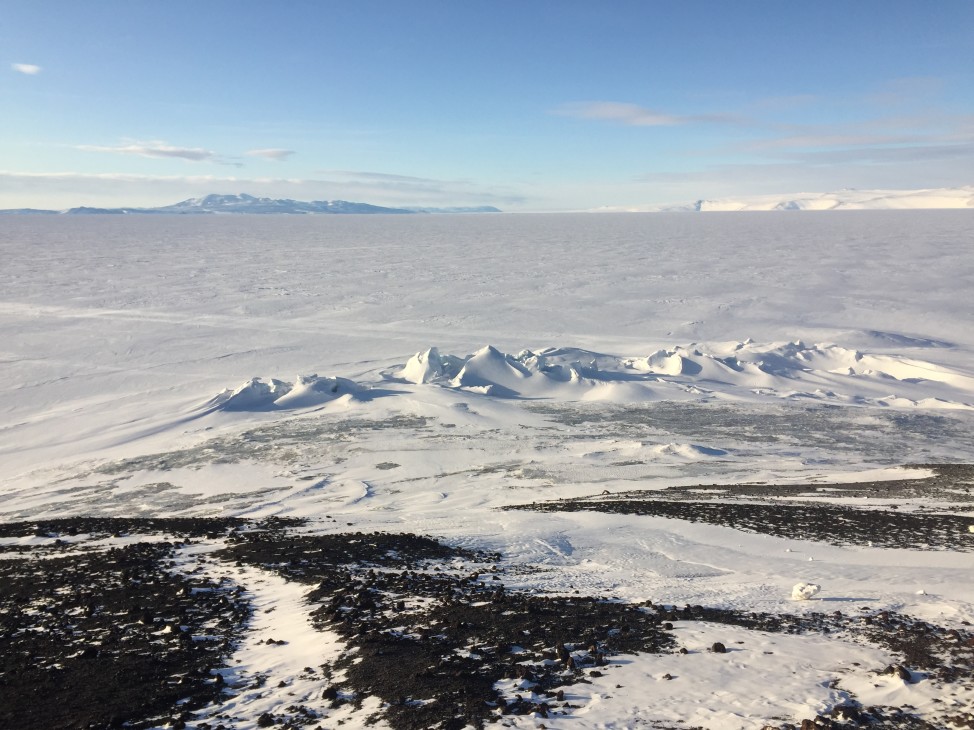
The pressure ridges (ice formations) below Observation Hill, a 754-foot hill adjacent to McMurdo Station in Antarctica. (Photo by Refael Klein)
It was early afternoon when our plane, an LC-130 operated by the New York National Guard, began its descent towards the ice runway at McMurdo Station, the logistics hub of the U.S. Antarctic Program.
Last I heard, ground temperatures were minus 31 Celsius (minus 25 Fahrenheit). In the next half hour, the plane would land and I’d leave the relative comfort of the temperature-controlled passenger cabin and walk into the coldest cold I’d ever experienced.
I watched the other passengers dig through their carry-ons and layer up, and tried to get an Idea of how I should dress. Images of me walking off the plane and being paralyzed by the chill ran through my head. It would be like jumping into a frozen lake; I’d exit the aircraft, lose control of my body in one enormous freezing shock, tumble to the ground, and drown in embarrassment.
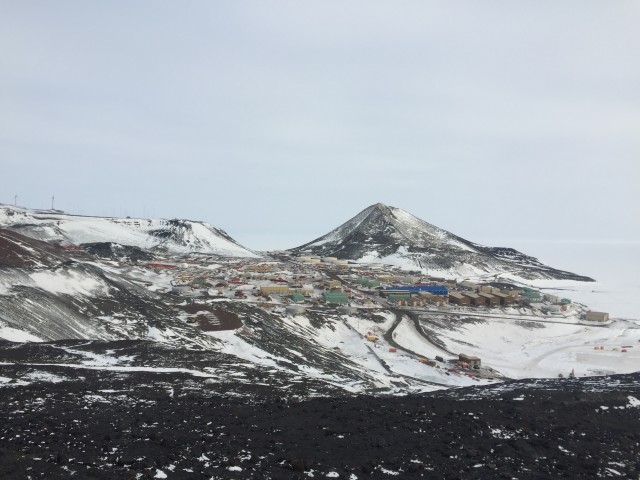
McMurdo is the largest base on Antarctica. Populations can reach over 1,000 during the summer months. (Photo by Refael Klein)
I put on everything I brought: two pairs of long underwear (tops and bottoms), a fleece, two down jackets, a balaclava, a ski hat, two pairs of gloves, and a pair ski goggles.
It got real hot, real quickly, and by the time the plane landed, the cold was no longer my adversary, it was my salvation.
With my feet firmly planted on the Ross Ice Shelf, I took off a jacket, removed my balaclava and replaced my goggles with a pair of sun glasses. The cool breeze swept over me and I relished it like a tall glass of lemonade on a hot August day in Washington, D.C..
About 30 meters (100 feet) away, five, red, 10-passenger vans were parked and idling. They’d be our ride to McMurdo.
Of the three American bases in Antarctica, McMurdo, on Ross Island, is the largest. It has been continuously occupied since the 1950s, first by the U.S. military, mainly the navy, and then by the National Science Foundation (NSF).
In the 1960s, the navy built a nuclear power plant below Observation Hill to meet the station’s energy needs. A decade later, with the Antarctic treaty in place, NSF administrators replaced navy staff officers and the plant was decommissioned and replaced with diesel electric generators.
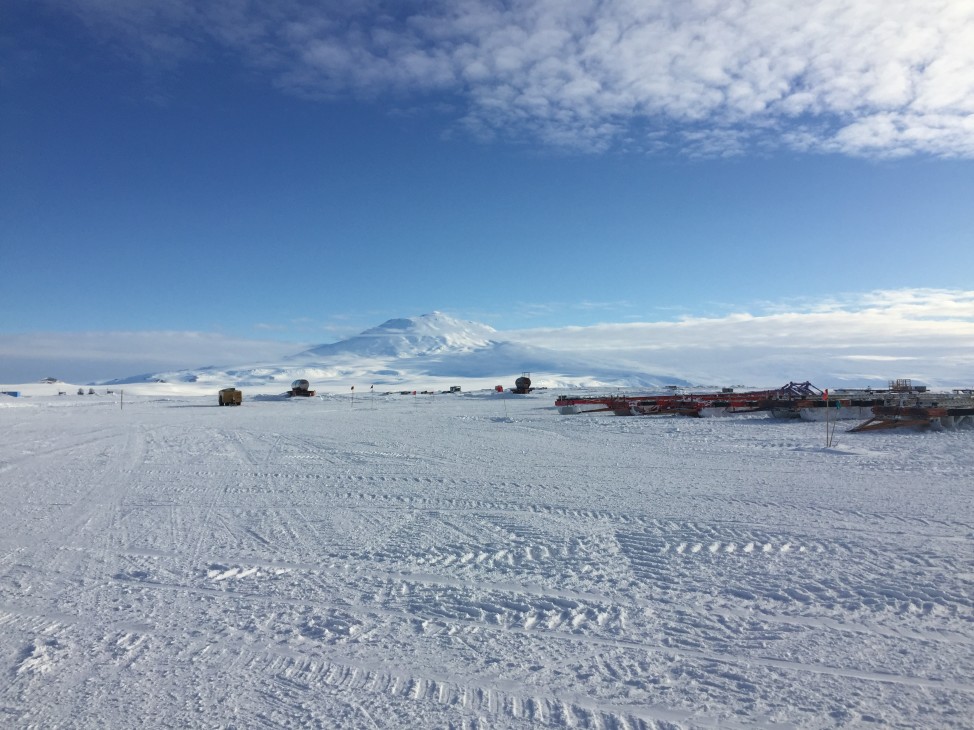
A view of Mt. Erebus from the McMurdo Skiway (airstrip), on the Ross Ice Shelf. (Photo by Refael Klein)
This time of year, McMurdo sees 24 hours of sunlight. It is perpetually three in the afternoon or 10 in the morning, depending on your perspective.
The sea ice is 1.5 meters (5 feet) thick and, except for the occasional tidal crack, there is no view of the open ocean, which sits 112 kilometers (70 miles) away. In two months, when the sea ice breaks up, the station will become a naturalist’s dream where killer whales, penguins and seabirds will abound. For now, there are only seals.
The oldest seal on the island is partially eaten and frozen to the ground beneath the wrap-around awning at Scott’s Hut. Robert Falcon Scott was the captain of the second expedition to reach the geographic South Pole.
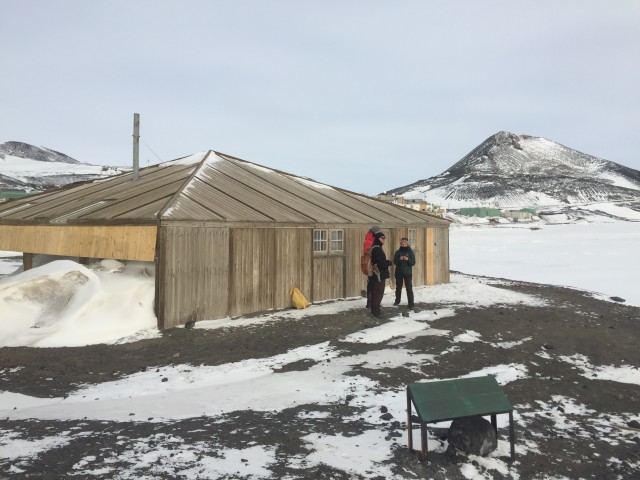
Scott’s Hut, which housed the second expedition to reach the geographic South Pole, still stands after more than 100 years. (Photo by Refael Klein)
He lived with his crew on Ross Island for two years, surviving off of canned biscuits and seal meat cooked over blubber stoves. The expedition, sans the South Pole party — all of whom died on their return journey — left Antarctica in 1913.
Despite its age, the original hut still stands. It’s in near-perfect repair, and if you peek through the windows, you can see shelves of neatly stacked, 100-year-old canned goods left behind by the expedition.
A beautiful, almost eerie, glow creeps in and around McMurdo throughout the day. Although one may think it’s the remnants of the old nuclear power plant, it’s in fact the combined effect of snow, clouds and glaciers reflecting light in all directions.
No feature glows more intensely than Mt. Erebus, the southernmost active volcano in the world, and the most dominant feature on Ross Island.
It’s an impressive sight to behold and, as you look over the Ross Sea and watch its glacial tongue creep across the frozen ocean, you momentarily forget the biting cold and extreme isolation. The vastness of the landscape is mesmerizing. Wind tears over rock and ice. Sirens call from distant mountain passes.
It takes one’s full strength to hold on to reality, and not be carried into the wilderness.
Look for Refael Klein’s weekly blogs from the South Pole here on Science World.

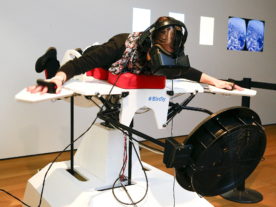




















I was very interested..you made it real….thank you for your time…i appreciate a summary like that, what you saw, how it felt…very good.
Thank you…joe
I really enjoy reading about your day to day experience. I look forward to more.
Thanks, Karen
Fantastic read. Meagan and I enjoyed it over breakfast. Instantly took us from Pago to the South Pole. Look forward to reading following installments. I always imagined the Antarctic as a static environment, but it sounds like the natural architecture is ever changing. You seeing waves in the ice formations yet? Miss you, brother.